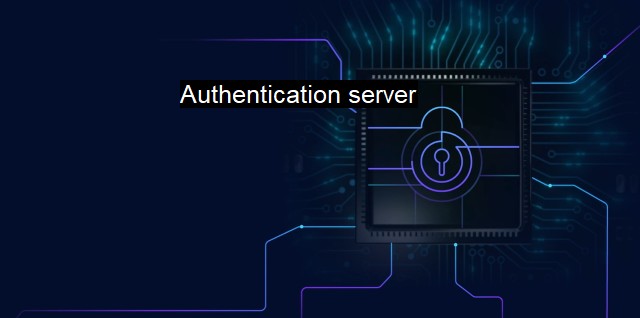What is Authentication server?
Importance of Authentication Servers in Cybersecurity: Safeguarding Organizations and Businesses from Cyber Threats and Attacks
Authentication server, falling under the scope of cybersecurity, is a crucial aspect of the network architecture that controls access to the network and its various resources by validating the credentials of any entity trying to access the network. Traditionally these entities typically involved users, who are asked to input their usernames and passwords. Nowadays this validation is often expanded to devices and applications as well. This concept is central to network safety and demonstrates a key stage of antivirus protection.The primary role of the authentication server is to authenticate, or validate the identities of, users, devices, or applications to safeguard an organization's system or network. Its duty includes managing and controlling tasks associated with the network's security. Notably, the measure is employed to verify the credentials of the entity attempting to access the network. Valid credentials mean that the user, device, or application has the rights to access the system or a certain part of the system, because their identity has been verified and recognized as reliable.
In terms of cybersecurity these servers play a paramount role, mainly because an incorrectly authenticated user, device, or application can so easily lead to a breach. Cybersecurity threats come in different forms and can vary in complexity. When an entity gets wrongly authenticated, it could potentially lead to unauthorized access to sensitive information, loss or alteration of data, and other harmful situations that could cripple an organization or expose it to risks such as legal penalties.
Recognition of correct credentials is the baseline policy of the authentication process which is handled by the server. Though, for more security, there are generally two other forms of validation also employed beyond mere recognition: something you have (like a card or a smart device) and something you are (like biometrics – a fingerprint or facial recognition). This defense mechanism of combining more elements beyond username and password is known as multi-factor authentication (MFA).
Authentication servers are also responsible for password management, including storage, encryption, and management of password changes and resets. This provides an additional layer of security as usernames and passwords are stored in an encrypted format, decreasing the possibility of interception by unauthorized entities.
Application of the robust principles of authentication server contributes greatly to antivirus defence mechanisms, offering security by inhibiting malicious applications, hackers, or devices from gaining access to the network. Integrated with antivirus software, an authentication server can help monitor network access, scan for suspicious activity like malware or virus attacks, and flag or block any unauthorized or potentially harmful access.
Authentication of end-points is equally important in antivirus protection, given that most breaches originate form endpoints like users' devices in a network. An authentication server can be used to ensure only known and secure devices can access the network, hence keeping harmful or untrustworthy devices out.
Key qualities of an effective server encompass ease of use for authorized entities, versatility in handling many types of authentication data, and robustness in resisting attempts to compromise its systems.
The role of an authentication server in cybersecurity and antivirus protection is prominently multi-faceted as it anchors both access and integrity of the system or network. Through single or multi-factor validation, password management and end-point authentication, it protects the network from threats of unauthorized access, data breaches, viruses and malware, ensuring business continuity and safeguard of sensitive data. it presents an essential aspect of any comprehensive cybersecurity policy or strategy.

Authentication server FAQs
What is an authentication server and how does it relate to cybersecurity?
An authentication server is a component of a cybersecurity system that verifies the identity of users attempting to access a network or system. It ensures that only authenticated users with proper authorization can access the system, which helps prevent unauthorized access and cyberattacks.What are the benefits of using an authentication server?
There are several advantages to using an authentication server for cybersecurity purposes. These include improved security, easier and more efficient management of user accounts and access control, and reduced risk of data breaches and cyberattacks due to unauthorized access. It also helps maintain compliance with data security regulations.What factors should be considered when selecting an authentication server for antivirus software?
When selecting an authentication server for antivirus software, consider factors like compatibility with other cybersecurity tools, ease of integration, scalability, reliability, and support for various authentication mechanisms such as biometrics, smart cards, and two-factor authentication. Also, ensure that the authentication server supports the organization's security policies and compliance requirements.How can an authentication server help prevent malware and virus infections?
An authentication server can help prevent malware and virus infections by authenticating user accounts and devices before granting access to the network or system. It can also enforce security policies, restrict access to sensitive data, and monitor user activity to detect and prevent suspicious behavior. Additionally, an authentication server can integrate with antivirus software to ensure that only authorized, up-to-date devices are allowed on the network, reducing the risk of malware and virus infections.| | A | | | B | | | C | | | D | | | E | | | F | | | G | | | H | | | I | | | J | | | K | | | L | | | M | |
| | N | | | O | | | P | | | Q | | | R | | | S | | | T | | | U | | | V | | | W | | | X | | | Y | | | Z | |
| | 1 | | | 2 | | | 3 | | | 4 | | | 7 | | | 8 | | |||||||